In Tibet, politics and religion have always been inseparable. At the beginning, the justification for this dangerous mix was that Buddhism would ‘cleanse’ and protect politics from abuse but this would only hold true if the principles of Buddhism are sincerely brought into play, to influence political decision-making. Instead it is much more common to see the religion being abused to explain away certain actions and decisions by the Tibetan government which seem to be devoid of logic and common sense.
1. A History of Oppression
For the Tibetan people, Buddhism has always been more than a belief and a system of worship. Buddhism, as it turns out, is also the instrument of social control that the Tibetan government uses to keep the people under its thumb. The Tibet before a young 14th Dalai Lama was catapulted into the world was a feudal theocracy and the vast majority (over 95%) of the Tibetan people were slaves and serfs who had to accept their fate ‘happily’ as they were told that this was their karma and it was wrong to resist their feudal lords.
By invoking distorted religious principles, the Tibetan leadership made the people believe that it was virtuous to accept their forced servitude, and with that, the populace was molded into an obedient workforce for the Tibetan lords. Every aspect of the Tibetan slave’s life was controlled from birth to death and everything was taxed including marriage, planting crops and owning an animal. Whatever of these taxes could not be paid were passed to the next generation, thus enslaving them as well.
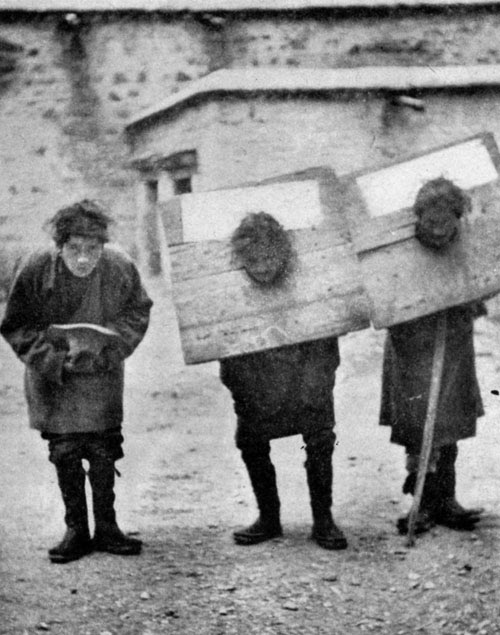
Cangued serfs were a typical sight in feudal Tibet
When the Dalai Lama escaped Tibet in 1959 and formed the Tibetan government in exile, this culture of subjugation and the use of religion as a political tool continued. But this time, the Tibetan government disguised itself as a libertarian leadership, a government of the people, a constitutional democracy and celebrated September 2nd each year since going into exile as ‘Democracy Day’. The Central Tibetan Administration (CTA), which Gaden Phodrang was now called, even declared that its Constitution was built upon the foundations of Dharma or the Buddha’s teachings. People the world over cheered the triumph of classless equality and the enfranchisement of every single Tibetan man, woman and child and suddenly the Sino-Tibetan conflict became a struggle between a reformist David against the intolerant and oppressive Goliath, the red peril known as the CCP (Chinese Communist Party).
Millions poured in from Tibet sympathizers around the world and even more in the form of subsidies and grants from Western liberal governments anxious to keep communism at bay. The Dalai Lama was given a Nobel Peace Prize for his peaceful and non-violent struggle against China even as Tibetan mothers mourned the loss of family who fell in a secret and vicious CIA-sponsored guerilla war that the Dalai Lama waged against China. In truth, little had changed for the Tibetan people who now lived in exile under a more well-practiced theocracy. The ‘law’ was still what the Dalai Lama and CTA deemed it to be. The CTA disbursed aid according to pledges of loyalty and those who did not toe the line were excluded from participation in financial and social welfare programs, denied political and legal processes and have been set upon by vigilante groups, resulting in greater hardships and isolation.
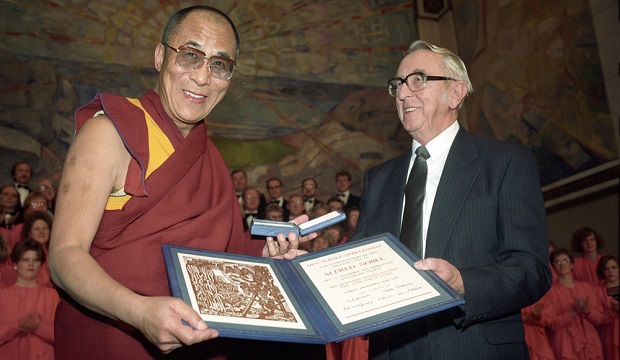
H.H. the 14th Dalai Lama was awarded the Nobel Peace Prize for his advocacy for a peaceful solution to the issue of Tibet
That the Tibetan government would deceive the people of the world, many of whom sympathized with the Tibetan plight, is something to be alarmed at and demands closer inspection of who this government really is. And when we actually look into their acts and recent history, we see an insidious government who has extorted the Tibetan people endlessly and wreaked untold damage unto the credibility, integrity and reputation of Tibetan Buddhism. Whereas the administration of the 5th and 13th Dalai Lamas were known to be ruthless politicians, it would be the government of the 14th Dalai Lama who would treat the ancient religion with such callousness whilst simultaneously drawing authority from it.
2. Religion at the Brunt of Politics: Some Evidence
(i) Going into exile provided the Dalai Lama and the Tibetan establishment with an unprecedented opportunity to seize absolute power. In old Tibet, the people’s allegiance to their respective Tibetan Buddhist schools stood in the way of Gaden Phodrang claiming totalitarian power. The Tibetan leadership, namely the Dalai Lama’s brother Gyalo Thondup (who is a significant figure in the Dalai Lama’s government), saw that as a great inconvenience. He sought to demolish all the different Tibetan Buddhist schools and merge them into a new one under the Dalai Lama and his government in exile.
This was in effect an attempted religious coup d’état not because those in power sincerely believed in the doctrinal superiority of their religious tradition but because they wanted absolute authority. All the four major lineages of Tibetan Buddhism – Nyingma, Kagyu, Sakya and Gelug – represent the entire composite of the Buddhist path, and comprise the essence of both sutra and tantra. Each one is precious and bears rich religious heritage, and together they weave a sacred and mystical tapestry that has come to characterize Tibet since the 2nd century CE. And this was what the government of the 14th Dalai Lama wanted to forcibly lay by the wayside to pave the way for them to enjoy absolute power.
There are two ironies here – first, the Dalai Lama and his government present themselves as great protectors of the Buddhadharma and indeed this is the spiritual leader’s appeal to the world. And yet, we see how they were going to unravel the rich fabric of Tibetan Buddhism that countless enlightened masters over the centuries had woven together. The second is that this happened merely one year after the Dalai Lama himself declared the Tibetan government-in-exile to be a democracy and had the year before (1964) promulgated a draft Tibetan Constitution to govern the Tibetans in exile that, amongst other rights, guaranteed the free worship of any religion a Tibetan chooses.
The plot for the Tibetan establishment to seize absolute power failed but not before Gungthang Tsultrim was found brutally murdered. He was the head of a group known as The Fourteen Settlements which had been formed to resist Gyalo Thondup’s attempted coup. When the murderer Rekhang Tenzin was caught, he admitted that he was paid by the Tibetan government-in-exile to assassinate Gungthang Tsultrim. In addition, he confessed that the CTA had also offered him a bounty to kill the 16th Karmapa, Ranjung Rigpe Dorje, the head of the Karma Kagyu school who were historically the greatest rivals to the Dalai Lamas. News such as this would have brought down any government where laws are upheld, but as this case revealed, the Tibetan leadership is a law unto itself. And so nothing happened although they had been shown to have had a direct hand in someone’s murder.
(ii) The 16th Karmapa was a prime target of the CTA due to his stature and high regard in the eyes of the Tibetan people. When The Fourteen Settlements group wanted a prominent religious figure to represent their collective ideals, they chose the 16th Karmapa who became the symbol of spiritual correctness and the heart of The Fourteen Settlements’ resistance. The Karma Kagyus were also the second largest Tibetan Buddhist school after the Gelugpas, the Dalai Lama’s own religious tradition, and therefore were perceived as a constant threat by the CTA. And true to the Machiavellian minds in the Tibetan government, this threat had to be dealt with.
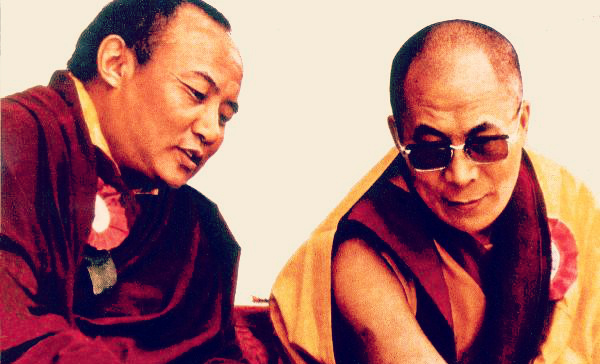
H.H. the 16th Karmapa Rangjung Rigpe Dorje and H.H. the 14th Dalai Lama
The opportunity came after the 16th Karmapa passed away and there were two rival contenders to the highest seat of the Karma Kagyu. In 1992, the Dalai Lama used his unrestrained authority to force his endorsement of a candidate in a process that has historically been a private Karma Kagyu affair. The CTA then carried out what some have described as a medieval dictatorial command – over and over again, the Dalai Lama appeared in photographs and at events with his chosen Karmapa candidate, thereby signaling clearly to the Tibetan people who they should direct their allegiances to. As these repeated appearances reinforced that one candidate was favored over another, the Tibetan leadership forced a wedge into an internal split that may well have found its own solution, and hammered into place with brutal force an intractable divide. The Tibetan leadership had succeeded in its plot to essentially undermine a sacred and ancient religious order which it regarded to be its spiritual and political rival and in the process held the new head of the Karma Kagyu beholden to its authority. And so forever, the holy lineage of the Mahasiddhas Tilopa and Milarepa, which has held its integrity for almost 1000 years, was compromised and even today violent clashes break out between the two rival groups from what was formerly a united school.
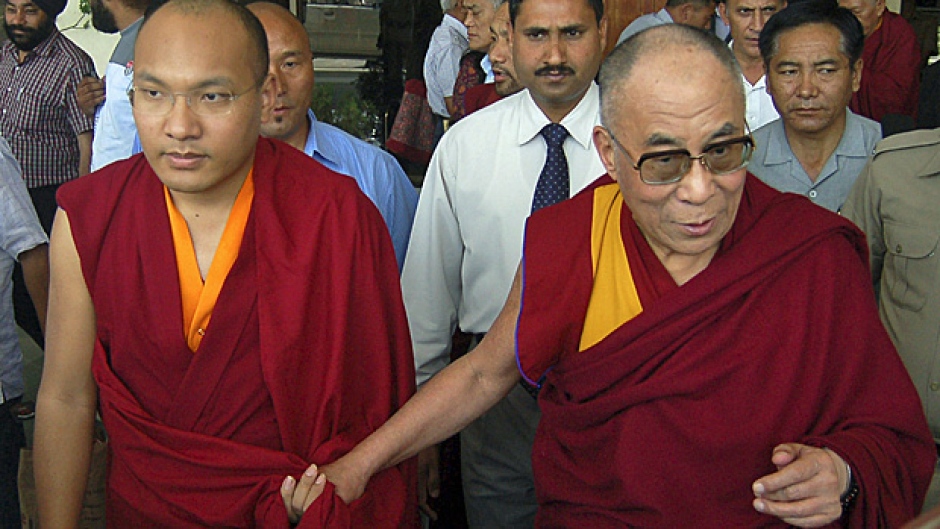
Karmapa Ogyen Trinley has long enjoyed a close relationship with H.H the 14th Dalai Lama
Had the interest of the Tibetan leadership been on the preservation of the sanctity of this precious lineage, it would have acted differently. It could have stayed out of an internal quarrel – after all, when did it become the policy of a democratic government to interfere in religious matters? Or it could have arbitrated the disagreement and brokered a solution. So again, it is evident that the CTA will not hesitate to destroy religion to stay in power.
(iii) For a self-professed democratic government upholding Buddhist principles, the attitude of the Tibetan government is more that of a war chieftain than a fair and equitable administration of the people. In such an environment, high lamas, scholars, politicians, monks, the people and religious institutions of the various traditions are merely pawns to be mobilized in a power game. If you toe the government’s line and even avail yourself to bolster its power base, then the Tibetan leadership will turn a blind eye when its allies engage in immoral activities, much like how an army general might allow his soldiers to plunder and loot a conquered town.
In September 2014, His Holiness the Gyalwang Drukpa, the head of the Drukpa lineage, issued a statement informing the public that Drukpa temples were being forcibly taken over and converted into Karma Kagyu monasteries allegedly under the instructions of the Dalai Lama’s Karmapa candidate, Ogyen Trinley. However, the plot was revealed to be more sinister than meets the eye. In his statement, His Holiness the Gyalwang Drukpa further said,
I did not believe then that His Holiness Karmapa Ugyen Thinley Dorjee would have given such an instruction because he was just a child at that time. Even today the name “His Holiness Karmapa Ugyen Thinley Dorjee” is being used to forcibly take over and convert the Drukpa Lineage monasteries to the Karma Kagyu. Historic pictures, images and art of Drukpa Lineage Lamas are being defaced and removed by the Karma Kagyu in an attempt to rewrite history. Despite what I have been informed, I still do not believe that His Holiness Karmapa Ugyen Thinley Dorjee would give instructions to forcibly take over Drukpa Lineage monasteries and convert them to Karma Kagyu.
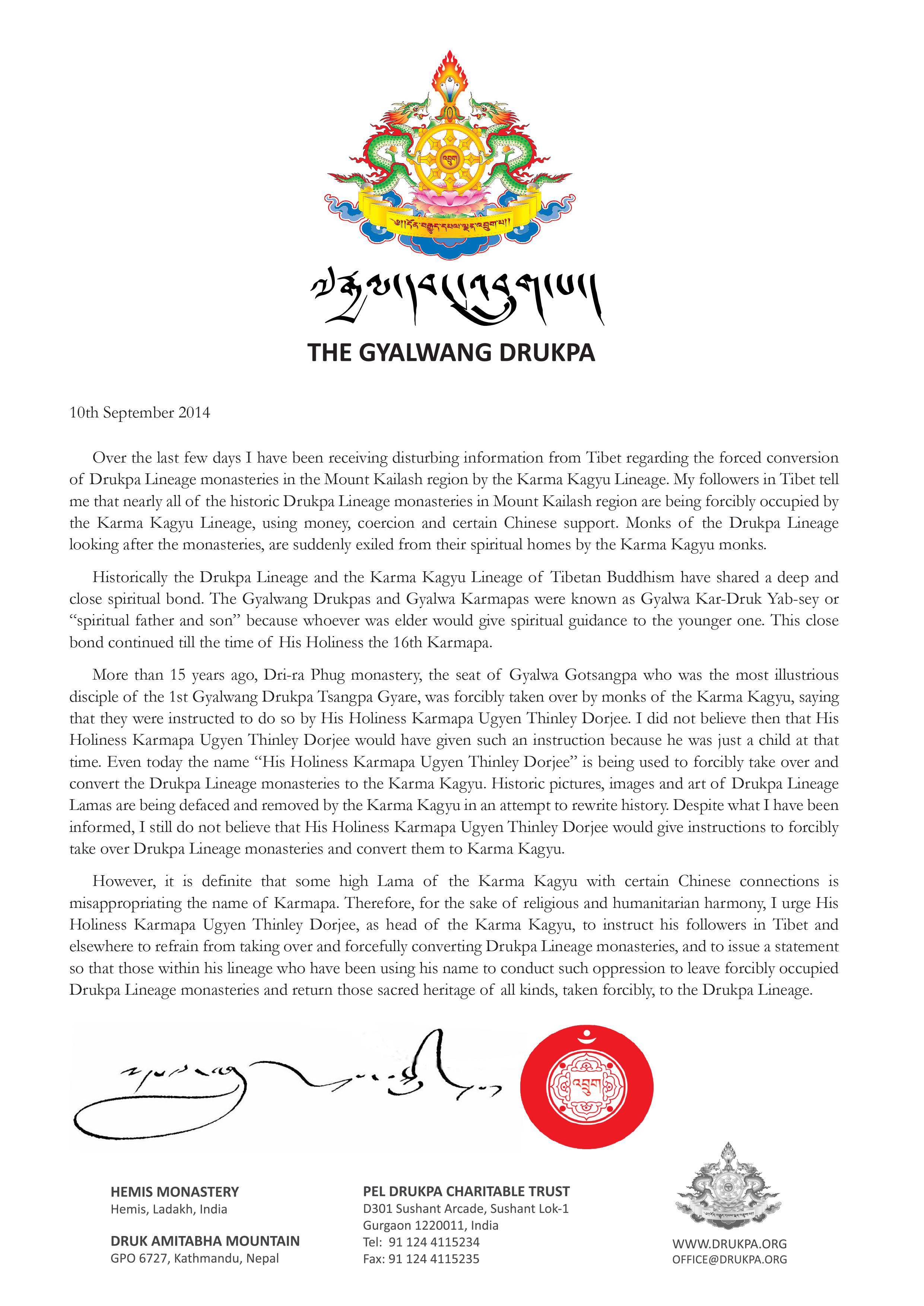
The Gyalwang Drukpa’s open letter regarding the forced conversions of Drukpa Monasteries and holy sites (Click to enlarge)
And yet, Dharamsala remains silent on this ongoing transgression by a member of its own coterie. Firstly, we see that abuse of power is rife amongst those close to the Dalai Lama. In addition, not only is this forced conversion a breach of the law but also a serious infraction of the vows that Kagyu monks are bound by. And yet, the Dalai Lama and CTA allow this. By remaining silent to such obvious acts of aggression, the Tibetan government in fact encourages more such activities to happen when people know they will not face consequences for such behavior carried out in the leadership’s name.
In the meantime, practices such as Dorje Shugden are unilaterally banned without recourse and without the CTA having to provide sound reasons for declaring a 400-year old practice to be a criminal activity. It is clear therefore that whether a spiritual activity, prayer, ritual, religious school, lineage, monk or an ordinary person is good or bad is purely based on the whims of Dharamsala and not based on any code of conduct or the law.
(iv) But the forced conversion of Drukpa monasteries is not an isolated case. In an open letter to the Dalai Lama dated May 1, 2016, Lodreu Rabsel Rinpoche, the General Secretary to the Karmapa Trinley Thaye Dorje, the rival to the Dalai Lama’s Karmapa candidate Ogyen Trinley, described very troubling developments. The open letter spoke of how the Karmapa Trinley Thaye Dorje was continually being harassed and prevented from performing his official spiritual duties by groups of people apparently “acting according to the Dalai Lama’s instructions”. Lodreu Rabsel Rinpoche went on to ask in his open letter,
…You [Dalai Lama] travel the world complaining about others not respecting the religious freedom of the Tibetan people, why do you not respect them yourself?
And in one sentence, Lodreu Rabsel Rinpoche addressed the crux of the Tibetan paradox – why is the CTA committing the same crimes that it wants the world to sanction China for?
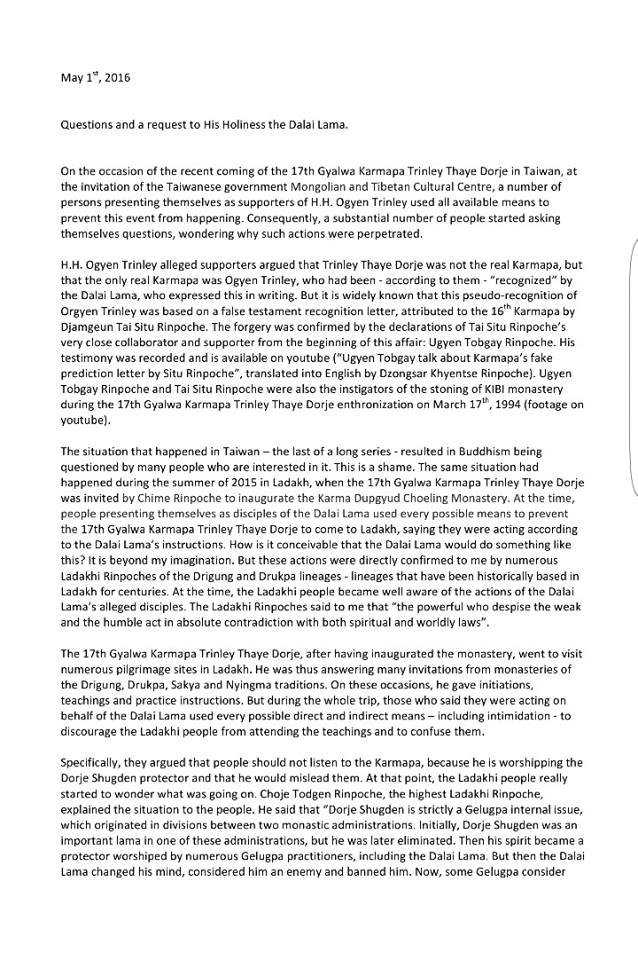
Page 1 (click to enlarge)
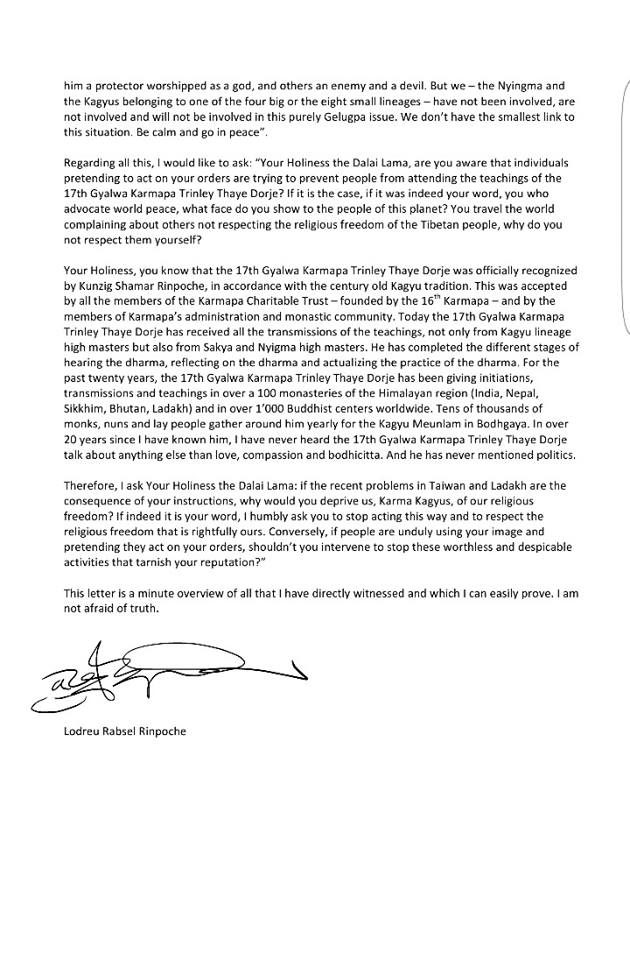
Page 2 (click to enlarge)
Again, there was no response from the CTA or the Dalai Lama’s office. Before that, Dharamsala had made sure the Karmapa Trinley Thaye Dorje was marginalized by spreading the rumor that he worships the Dharma Protector Dorje Shugden, whom the CTA had banned and criminalized by alleging rather irrationally that everyone associated with this practice is on the payroll of their enemy, China.
(v) The Dorje Shugden conflict is by far the clearest and most irrefutable example of how the Tibetan government uses religion as a political instrument that they wield ruthlessly. It is also a blatantly obvious illustration of the CTA’s disregard for its own Constitution and the Tibetan people’s rights.
For reasons that have never been made clear, the highly regarded Dharma Protector of the Gelugpas, Dorje Shugden, was suddenly outlawed in 1996 after the Tibetan leadership began to speak against it in the late 1980s. Dorje Shugden had been central to the Gelugpas’ spiritual life for centuries and prior to the ban on the practice, over 90% of Gelugpas including the Dalai Lama worshipped this deity.
Even though the most senior lamas in the Sakya and Gelug traditions worshipped Dorje Shugden as a Buddha over the centuries, none of that stopped the Dalai Lama from suddenly declaring this deity to be an evil spirit that should be forbidden. In this, the Tibetan leadership showed complete disregard for the beliefs of others and afforded even less respect for their rights which are supposedly guaranteed by law. Later on, when the claim of Dorje Shugden being a demon could not be sustained because it was easily debunked, the justification to criminalize the religion suddenly shifted to Dorje Shugden being a Chinese ghost and all of its practitioners (including the Dalai Lama at one time) being agents of Communist China working to destabilize the Tibetan government. The magnitude of this idiocy is difficult to articulate in words; it is like a world leader banning Catholicism and declaring that if you are a Catholic priest, then you must be a pedophile.
As can be seen in this case, whatever the Tibetan leadership says automatically becomes a law that all Tibetans are obliged to obey lest they are accused of being anti-Dalai Lama or pro-China. All they have to do is say “The Dalai Lama said so” and their diktats are automatically enshrined as law. Even so, the Tibetan leadership’s Cabinet and Parliament went so far as to pass various official resolutions making it mandatory for all Tibetans to hate worshippers of Dorje Shugden. Thus in the years after 1996, the CTA successfully spawned a vicious hate campaign against core members of the Gelugpa monastic community and drove a wedge deep into the heart of the Tibetan populace both in Tibet and in exile.
3. Conclusion
Dharamsala’s war against Dorje Shugden is in fact a war against its own monastic establishments because virtually all the highest and most senior monks of the tradition practiced the deity Dorje Shugden. And if the Tibetan people were to believe in the CTA’s version of the story, they must absolve their allegiance to their respective lineage masters who regard Dorje Shugden as a benevolent Buddha. In the same manner that the Karma Kagyu school was divided irreparably over the Karmapa issue, the Gelugpa tradition was torn asunder and the lay and monastic community scattered. The main Gelugpa monasteries – Ganden Monastery and Sera Monastery – were split, old and established bonds were severed, and monks were expelled or disrobed in disgust, because they could not withstand the hate campaigns the Tibetan government had initiated.
The CTA have broken the backs of the Gelugpa and Karma Kagyu schools of Buddhism. Together, these two spiritual lineages account for the bulk of the Tibetan population inside and outside Tibet. As a result, the majority of Tibetans are now confused and dislodged from old loyalties, precisely the result the CTA had originally intended from the time Gyalo Thondup sought to weaken the influence of the various schools to strengthen the secular leadership’s power. But the damage stretches far beyond sectarian lines as many around the world have lost confidence in the religion after witnessing the vicious infighting and endless barrage of propaganda and disinformation.
How is anyone to know what is true and can be believed and what is false? If the government of Avalokiteshvara can commit such heinous crimes, then there is nothing sacred about this religion. And so, in the wake of the Tibetan government’s political scheming, Tibetan Buddhism lies broken, uprooted and defamed. Never has Tibetan Buddhism been so weak as it is today and finally the Tibetan government-in-exile seems to be succeeding where the evil king Langdharma failed. The Tibetans may have lost their country to an external challenger but the spiritual tradition of the people, which is the heart and soul of Tibet, has been lost to the greed and corruption of their own leadership. What took attained masters centuries to build and assemble has been dismantled in just a few decades, and this will be the legacy of the 14th Dalai Lama’s Central Tibetan Administration.
MORE NEWS LIKE THIS